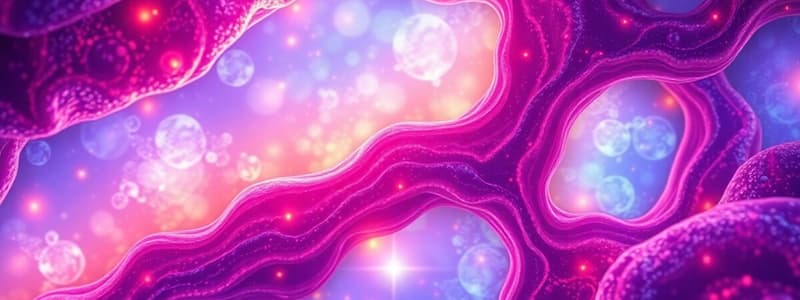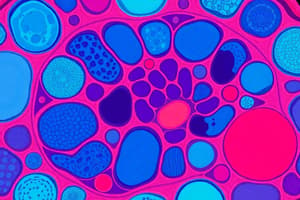Podcast
Questions and Answers
Which tissue type is characterized by characteristics of polarity and having specialized contacts?
Which tissue type is characterized by characteristics of polarity and having specialized contacts?
- Nervous tissue
- Epithelial tissue (correct)
- Muscle tissue
- Connective tissue
What is a key difference between exocrine and endocrine glands?
What is a key difference between exocrine and endocrine glands?
- Endocrine glands internally secrete substances like hormones. (correct)
- Exocrine glands secrete hormones directly into the bloodstream.
- Exocrine glands have a vascular network for their secretions.
- Endocrine glands secrete enzymes outside the body.
Which characteristic is NOT associated with connective tissue?
Which characteristic is NOT associated with connective tissue?
- Cells embedded in an extracellular matrix
- All originate from mesenchyme
- Varying degrees of vascularity
- Have high vascularity in all types (correct)
Which type of connective tissue is known for its role in storing nutrients?
Which type of connective tissue is known for its role in storing nutrients?
What component of connective tissue helps to bear weight and withstand tension?
What component of connective tissue helps to bear weight and withstand tension?
Which type of fiber in connective tissue is known for providing high tensile strength?
Which type of fiber in connective tissue is known for providing high tensile strength?
Which type of connective tissue is primarily avascular?
Which type of connective tissue is primarily avascular?
What type of cell in connective tissue is responsible for maintaining the health of the extracellular matrix?
What type of cell in connective tissue is responsible for maintaining the health of the extracellular matrix?
What is the primary function of areolar connective tissue?
What is the primary function of areolar connective tissue?
Where is adipose tissue primarily located in the body?
Where is adipose tissue primarily located in the body?
Which type of connective tissue provides a framework that supports blood cells?
Which type of connective tissue provides a framework that supports blood cells?
What characterizes dense regular connective tissue?
What characterizes dense regular connective tissue?
What specific type of adipose tissue helps generate heat, especially in infants?
What specific type of adipose tissue helps generate heat, especially in infants?
Which function is NOT associated with areolar connective tissue?
Which function is NOT associated with areolar connective tissue?
What is NOT a characteristic function of reticular connective tissue?
What is NOT a characteristic function of reticular connective tissue?
Which tissue type is involved in the connection of muscles to bones?
Which tissue type is involved in the connection of muscles to bones?
Flashcards are hidden until you start studying
Study Notes
Tissue Types
- Nervous tissue transmits signals throughout the body.
- Connective tissue supports, protects, and binds other tissues.
- Epithelial tissue covers surfaces, forms glands.
- Muscle tissue responsible for movement.
Epithelial Tissue Functions and Characteristics
- Functions: protection, absorption, filtration, excretion, secretion, sensory reception.
- Characteristics:
- Polarity: Distinct apical (free) and basal surfaces with different structures and functions.
- Specialized Contacts: Cells tightly connected through junctions, minimizing gaps.
- Supported by Connective Tissue: Underlying connective tissue provides support.
- Avascular: Lack blood vessels, nourishment from underlying tissue.
- Innervated: Contains nerve endings for sensation.
- Regeneration: Cells constantly renew and replace.
Exocrine vs. Endocrine Glands
- Exocrine glands: Secrete products through ducts to outer surface, such as sweat glands.
- Endocrine glands: Secrete hormones directly into bloodstream, such as thyroid gland.
Connective Tissue Characteristics
- Embryonic Origin: All connective tissues arise from mesenchyme.
- Vascularity: Varying degrees of blood vessel presence, cartilage is avascular while bone is highly vascularized.
- Extracellular Matrix (ECM): Cells are embedded in ECM, composed of ground substance and fibers.
- Ground substance: Unstructured gel-like material that fills the space between cells.
- Components: interstitial fluid, cell adhesion proteins, proteoglycans, and water.
- Fibers: Provide support:
- Collagen: Strongest, resists tension.
- Elastic: Stretchy and recoil.
- Reticular: Short, branched, form supporting networks.
- Ground substance: Unstructured gel-like material that fills the space between cells.
Connective Tissue Cells
- Blast cells: Immature form of cell that actively secretes ECM:
- Fibroblasts: In connective tissue proper.
- Chondroblasts: In cartilage.
- Osteoblasts: In bone.
- Hematopoietic: Stem cells in bone marrow.
- Cyte cells: Mature, less active form, maintain matrix.
- Fat cells: Store nutrients.
- White blood cells: (neutrophils, eosinophils, lymphocytes) for tissue response to injury.
- Mast cells: Initiate inflammatory response.
- Macrophages: Phagocytic cells, “eat” dead cells and microorganisms.
Connective Tissue Types
-
Connective Tissue Proper:
- Loose Connective Tissues:
- Areolar: Supports and binds tissues, holds fluids, defense against infection, nutrient storage.
- Adipose: Stores nutrients (White Adipose Tissue), supports local nutrient needs, generates heat (Brown Adipose Tissue).
- Reticular: Supports free blood cells, forms internal framework for organs.
- Dense Connective Tissues:
- Dense Regular: Provides tensile strength, connects structures.
- Dense Irregular: Withstands tension from multiple directions, provides structural strength (dermis of skin, fibrous capsules of organs).
- Loose Connective Tissues:
-
Cartilage: Strong, flexible, shock-absorbing tissue, avascular.
- Hyaline cartilage: Most common, found in nose, trachea, ribs, embryonic skeleton.
- Elastic cartilage: Flexible, found in ear and epiglottis.
- Fibrocartilage: Strongest, found in intervertebral discs and menisci.
-
Blood: Fluid connective tissue that transports gases and nutrients.
-
Bone: Hard, calcified connective tissue, provides support and protection.
- Compact bone: Dense, outer layer of bone.
- Spongy bone: Porous, inner layer of bone.
- Bone marrow: Produces blood cells.
Studying That Suits You
Use AI to generate personalized quizzes and flashcards to suit your learning preferences.




